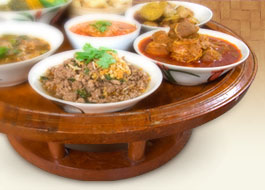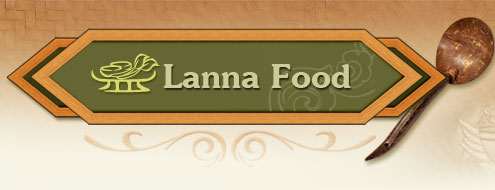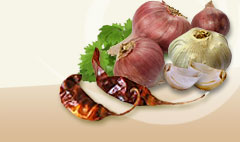Phak wan ban |
|
|
 | Sauropus Androgynus Merr. |
|
| |
 | Euphorbiaceae |
|
| |
 | Cha phak wan (Northern), phak wan ban (Dentral) (Kanchana Diwiset, et al., 2005, p. 143; Wut Wuthithamwet, 1997, p. 298); phak wan tai bai (Malaysian-Satun) (Wut Wuthithamwet, 1997, p. 298); tho lui kanido (Agricultural Extension Department, 2007) |
|
| |
 | Small shrub, 2-3 m high. Branches slender, grayish white, slightly bend at the nodes,. Leaves simple, alternate, short petiole, ovate-lanceolate, distichous, 1.5 cm wide, 2.6 cm long. Upper part of leaf stem is dark but lower part is light green. Inflorescence of cymes, axillary, composed of male and female flowers, with a yellow or red calyx, apetalous. Fruit globous, fleshy, green to white, 1 cm. in diameter with red stem; Seeds blackish. (Kanchana Diwiset et al., 2005, p. 143) |
|
| |
 |

Phosphorus, calcium, iron, Vitamins A, B1, B2, C, fat, niacin, protein, carbohydrates. (Phak Phuen Ban Ahan Phuen Mueang, 2007, p. 62) |

Liquid from the leaves and plants used for treatment of eye infections, inner nose wounds. Roots can reduce body heat and fever as well as diphtheria. (Kanchana Diwiset, et al., 2005, p. 143; Wut Wuthithamwet, 1997, p. 298) Leaves are an ingredient in herbal medicine to treat fever (Kanchana Diwiset, et al., 2005, p. 143)
Lana Pharmaceutical Indications: its roots used in medicine to treat skin cancer, leukemia, mouth sores and gum diseases, toxins, boils in the ears and sties (Rattana Phromphichai, 1999, p. 7490)
|
|
| |
 | Rainy season (Kanchana Diweset, et al., 2005, p. 143) |
|
| |
 |
Agricultural Extension Department. (2007). Phak Phuen Ban. Retrieved 10 June 2007from http://singburi.doae.go.th/acri (in thai). Kanchana Diwiset, et al., compilers. (2005). Phak Phuen Ban Phak Nuea. Phennapha Sapcharoen, editor. (2nd ed.). Nonthaburi: Center for the Development of Text on Traditional Thai Medicine. (in thai). Phak Phuen Ban Ahan Phuen Mueang. (2007). Bangkok: Fa Aphai, Co., Ltd. (in thai). Rattana Phromphichai. (1999). Wan Ban, Phak. InSaranukrom Wattanathamthai Phak Nuea (Vol.14,p.7490). Bangkok: The Siam Commercial Bank Foundation for the Encyclopedia of Thai Culture. (in thai). Wut Wuthithamwet. (1997). Saranukrom Samunphrai: Ruam Lak Phesatchakam Thai. Bangkok: Odeon Store. (in thai). |
|
| |
|
|




